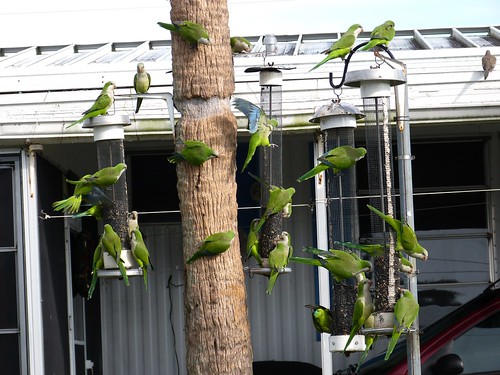 Flock of Monk parakeets feeding. Image by d.yodock Scientists to study birds' impact on native species
Flock of Monk parakeets feeding. Image by d.yodock Scientists to study birds' impact on native species
Their squawk sounds like thumbtacks going down a trash disposal. Their habit of nesting on power lines causes blackouts and millions of dollars in damage.
Yet the monk parakeets that have colonized South Florida over the past 40 years have attracted a devoted following of people who love these intelligent, gregarious, brightly colored transplants from South America.
But non-native species can be bad news for established wildlife, as in the case of Burmese pythons wiping out Everglades mammals, lionfish gobbling up native reef fish or Australian pine trees crowding out native vegetation. Now scientists at Cornell and the University of Chicago are asking anyone with a bird feeder to write down observations that could help them learn whether monk parakeets are thriving at the expense of native species by taking away their food or living space.
"They're large and they're in big flocks, so it's certainly possible they're displacing other birds," said Emma Greig, of the Cornell Lab of Ornithology FeederWatch (feederwatch.org). "I think it's very possible we'll find they're having no impact on native populations, so it could be good news for people who love having them in their yards."
These people are legion, and they are fierce defenders of a bird they say deserves a place in South Florida.
"I think that the other birds are actually more aggressive than a flock of these little guys," said Jessika Boyles, of Margate. "My neighbor feeds them, but when the black birds and blue jays come around the parakeets high-tail it. They are a great reminder that I'm in South Florida, and I appreciate the fact that even with all the continued construction, a never-ending story, they have still found places to stay local and mate."
Native to Argentina, Uruguay and other South American countries, monk parakeets, also known as quakers, arrived in the United States via the pet trade. They are thought to have escaped from damaged shipping crates and cages, as well as being intentionally released.
Although they have established breeding populations in New York City, Chicago and other northern cities, they are most numerous in Texas and Florida, with one estimate putting the Florida population at 100,000.
Jo Davey, of Deerfield Beach, co-author of the book Parrots in the City, says the bird may be filling the niche vacated by the extinction of the Carolina parakeet in the early 20th century. And they are a charming addition to the urban landscape — talkative, busy, colorful birds.
"Yes quakers are noisy — but it is a welcomed noise," she said. "Having a feeder full is exciting — the 'talking' and sharing — they are such animated birds. They do everything in groups. They eat in groups, they bathe in groups, they squawk in groups.
"They're fun to watch. It's better than TV. There's a lot of attitude in a little package," she said.
Their squawks — irritating to some, a source of charm to others — are as individual as fingerprints, Greig said, allowing the birds to stay with their group and locate their mates. And the birds are smart enough to adapt to local conditions, using South Florida's abundance of artificial structures to make their nests.
"They are quite happy to make a nest in power lines," she said.
Less happy about this is Florida Power & Light Co., which blames the birds for significant power outages in Broward, Miami-Dade and Palm Beach counties.
"Over the years, FPL customers have paid millions of dollars in repair costs for damage caused by exotic species like the monk parakeet," company spokesman Bill Orlove said. "These nests — some of which can be as large as a car — have damaged equipment and have resulted in tens of thousands of customers losing power. Since 2001, the monk parakeet's damage has created 2.1 million minutes of interruption for our customers."
FPL has hired a company to remove the nests, which he said is done without harming the birds when possible.
"The vendor shoos the birds away and takes the nest," he said. "The nest is really the issue. If there are chicks in the nest unable to fly, our vendor humanely euthanizes them."
While non-native species can harm local wildlife, experts say there's not much evidence this is happening with monk parakeets.
An analysis by the University of Florida found their impact is "likely minimal," since they tend to nest on human-made structures and obtain much of their food from bird feeders.
It's unclear what would happen if the parakeets were found to be harming native species. In extreme cases, state and federal wildlife agencies have attempted to eradicate exotic species, but there's no indication that would happen in the case of monk parakeets.
The Florida Fish and Wildlife Conservation Commission, busy contending with non-native horrors such as the Burmese python, Nile monitor and Asian swamp eel, says there's been no evidence these colorful birds are causing any environmental harm.
"We haven't documented anything," said Kristen Sommers, the agency's exotic species coordination section leader. "Sometimes we'll get calls because they're just noisy."